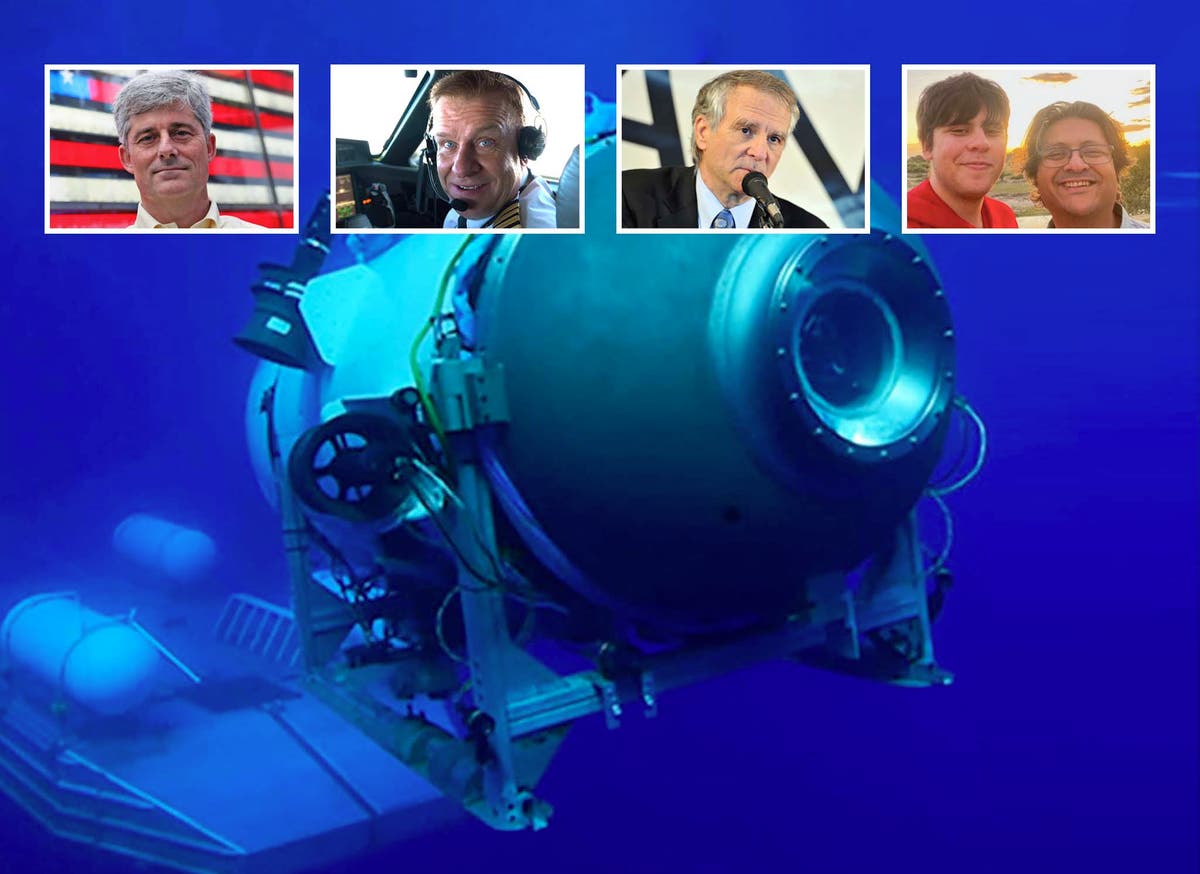Zero contact in four days and oxygen exhausted: What we know about missing Titanic sub
Search and rescue teams are in a race against time to find a Titanic tourist submersible believed to be in the Atlantic Ocean – as the vessel is feared to have run out of air. Ariana Baio and Rachel...

Sign up to our Evening Headlines email for your daily guide to the latest news
Sign up to our free US Evening Headlines email
A British billionaire explorer, a Pakistani father and son, a French diver and the CEO of a submersible tourist company are in a race against time for their lives as the 96-hour window to save them is closing in.
On Sunday (18 June) morning, OceanGate Expedition’s submersible, the Titan, left its surface ship around 900 miles east of Cape Cod, Massachusetts. The five passengers aboard were hoping for a once-in-a-lifetime trip, getting to view the Titanic wreckage.
Follow the latest updates on the missing Titanic submarine here
But, in a chilling echo of the fate of the doomed 1912 vessel, the adventure took a dramatic turn.
Just one hour and 45 minutes into the journey, the submersible lost contact with the surface ship.
Five things we know about the missing Titanic submersible
Now, more than three days on, the watercraft is nowhere to be found.
In a press conference on Tuesday (20 June) afternoon, Captain Jamie Frederick of the US Coast Guard assured people that authorities are doing everything possible to locate the missing vessel as the search intensified with more technology.
Mr Frederick confirmed that the vessel has“40 to 41 hours” of oxygen supply left, meaning it is expected to run out around 5.30am ET on Thursday.
He also acknowledged that officials do not know if crews will be able to rescue the people on board even if they do manage to find the sub before the oxygen runs out.
In a dramatic turn, a Canadian aircraft searching for the missing sub detected intermittent banging noises from the vicinity where the divers were last located. The crew heard banging sounds every 30 minutes on Tuesday and again four hours later, after additional sonar devices were deployed.
Here’s what we know so far:
What happened?
On Sunday morning (18 June) at 9am Atlantic Daytime Time, the Titan, a submersible owned by OceanGate Expeditions, set off on its excursion to the Titanic’s underwater grave with the research vessel the Polar Prince.
The expedition began with a 400-nautical-mile journey out into the Atlantic Ocean, about 900 miles off the coast of Cape Cod, Massachusetts.
Titan prepares to launch from its submersive platform on a test run
(OceanGate/YouTube)
The submersible was then released from its surface ship and began its descent 13,000 feet below the water’s surface to the wreckage.
The vessel is supposed to transmit a signal back to the Polar Prince every 15 minutes but it lost contact around 11.47am ADT, one hour and 45 minutes into the submerge.
What happened to the sub and its occupants remains a mystery.
Former British Navy Rear Admiral Chris Parry told Sky News that the OceanGate Expeditions vessel could have fallen foul of a “catastrophic failure” or even have become tangled up in the debris of the famed shipwreck.
“There’s an optimistic option and that’s that it’s either lost an umbilical communication with the surface or indeed there’s been a malfunction and the submarine continues to operate but obviously out of contact with its mother ship,” Mr Parry said.
“Obviously on the other end of the scale, there could have been an accident. It could have become entangled in the wreckage of the Titanic. It could indeed have had a catastrophic failure.”
The OceanGate Expeditions submersible vessel named Titan
(PA Media)
OceanGate Expeditions alerted the US Coast Guard around 6.40pm ADT after the missing sub after failed to surface and its expected time, 4pm ADT.
Immediately, a search effort began for the overdue submersible.
Where did it go missing?
It is unclear where exactly the sub went missing but the= US Coast Guard said it was searching 900 miles east of Cape Cod – where the famed Titanic shipwreck lies beneath the surface.
The Titanic shipwreck sits approximately 12,500 feet at the bottom of the Atlantic Ocean, about 380 nautical miles south of Newfoundland, Canada and 1,240 nautical miles east of New York City.
The shipwreck’s coordinates are 41º43’32”N, 49º56’49”W.
The US Coast Guard said it was searching in water depth of “roughly 13,000 feet”.
In a press conference on Monday (19 June), Rear Admiral John Mauger said the area the submersible went missing is “remote” which makes the search challenging. Combined with the fact that the sub could be on the surface of the ocean or underneath makes for a challenging operation.
OceanGate said in a statement: “Our entire focus is on the crewmembers in the submersible and their families”.
It added that the company is “deeply thankful for the extensive assistance we have received from several government agencies and deep sea companies in our efforts to establish contact with the submersible.”
At Tuesday’s press conference, US Coast Guard Captain Jamie Frederick confirmed that there is still no sign of the Titan. He gave a damning estimate that those on board the vessel now have just 40 hours of oxygen supply left inside the sub.
While Captain Frederick hammered home that it is “an estimate”, under the parameters, the oxygen supply will run out by 5.30am ET on Thursday.
The world’s deepest under sea search and rescue mission
Multiple agencies, multiple nations and both private and public entities are desperately working together to locate and rescue the five missing on board the Titan submersible.
The search is unlike anything that has ever been executed before – making this the deepest underwater search and rescue mission in the world.
Search and rescue efforts are being led by the US Coast Guard in Boston but the Canadian Coast Guard, Canadian Armed Forces, US Navy and others are involved in the search.
The US Coast Guard deployed two C-130 aircrafts, the New York Air National Guard deployed another C-130, the Canadian Coast Guard deployed one C-130 and one P-8 aircraft.
A US Navy Curv-21, an unmanned submersible vessel that can reach a depth of 20,000 feet, is being used in the search for the missing Titanic wreck vessel
(US Navy)
In addition, several Canadian Coast Guard ships, a French research vessel L’Atalante and commercial vessels are being used in the search.
The Royal Canadian Navy has also deployed HMCS Glace Bay, which carries a medical team specialising in dive medicine. Onboard the ship is a six-person mobile hyperbaric recompression chamber that can be used to treat or prevent decompression sickness.
As of Tuesday (20 June), over 10,000 square miles had been searched.
But, despite the multi-agency mission, David Concannon, an attorney and explorer who pulled out of the Titanic expedition at the last minute, claimed that the rescue efforts have been hampered by red tape, bureaucracy and a lack of urgency by the US government.
Banging noises overheard
One Canadian P-8 aircraft reportedly detected intermittent banging noises from the area the divers disappeared on Tuesday (20 June).
On Twitter, the US Coast Guard based in Boston said it “detected underwater noises in the search area. As a result, ROV operations were relocated in an attempt to explore the origin of the noises.
Internal email updates sent to Department of Homeland Security leadership read: “The P-8 deployed sonobuoys, which reported a contact in a position close to the distress position. The P8 heard banging sounds in the area every 30 minutes. Four hours later additional sonar was deployed and banging was still heard.”
The memo however did not state exactly when the banging was heard.
The Coast Guard wrote: “Those ROV searches have yielded negative results but continue.”
Who are the five missing?
Hamish Harding is one of the people aboard the Titan.
Mr Harding, 58, previously travelled on the Challenger Deep to the bottom of the ocean and on Jeff Bezos’ Blue Origin into space. He wrote on Facebook on Saturday to announce that he was joining OceanGate Expeditions for its Titanic mission this week.
“I am proud to finally announce that I joined OceanGate Expeditions for their RMS TITANIC Mission as a mission specialist on the sub going down to the Titanic. Due to the worst winter in Newfoundland in 40 years, this mission is likely to be the first and only manned mission to the Titanic in 2023,” Mr Harding wrote.
Hamish Harding
(Jannicke Mikkelsen via REUTERS)
He has not posted online since.
On Monday – as news of the missing submersible broke – Mr Harding’s stepson Brian Szasz confirmed that his stepfather was on board the vessel when it went missing.
The father-of-two is a seasoned explorer and holds three Guinness World Records, including the longest duration at full ocean depth by a crewed vessel when in March 2021, he and ocean explorer Victor Vescovo dived to the lowest depth of the Mariana Trench. In June 2022, he went into space on Blue Origin’s New Shepard rocket.
Paul-Henri Nargeolet, 77, is also one of the five.
A friend – and fellow Titanic expert – Larry Daley confirmed to CBC that Mr Nargeolet, French diver, was also on the vessel. Mr Nargeolet is described by OceanGate as the “Titanic’s greatest explorer” and has done 35 dives in the submersible.
Paul Henri Nargeolet, director of underwater research at Premier Exhibitions, Inc
(Getty)
Shahzada Dawood, a 48-year-old businessman and his 19-year-old son Suleman Dawood were also on the Titan to visit the Titanic wreckage.
The Dawood family released a statement about the father and son saying: “We are very grateful for the concern being shown by our colleagues and friends and would like to request everyone to pray for their safety.”
Shahzada Dawood is confirmed missing on the submarine
(WEF)
The fifth person was confirmed to be OceanGate Expeditions CEO Stockton Rush – the company confirmed in a statement on Tuesday afternoon.
Mr Rush, 61, began his career as a pilot before obtaining an undergraduate and MBA. He founded OceanGate Expeditions in 2009.
OceanGate CEO Stockton Rush
(OceanGate)
OceanGate offers excursions to shipwrecks and other deep-sea voyages for paying customers. In recent years, trips to view the Titanic shipwreck have become increasingly popular.

 Astrong
Astrong 
































